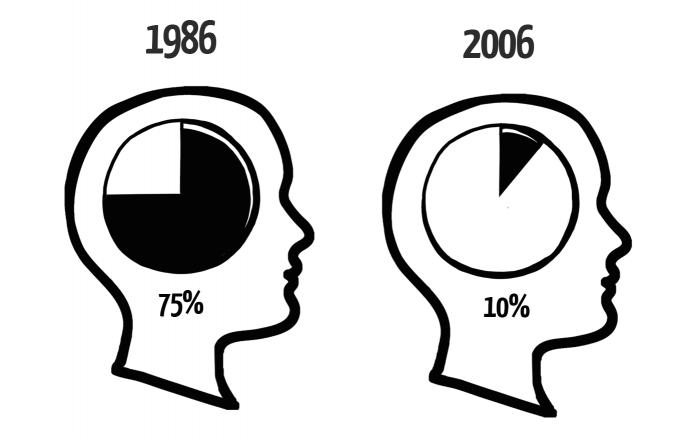Learning on demand
Look at that! We just came across a study that, despite being a bit dated, clearly presents what each of us probably feels very keenly at work.
Not only is the knowledge we need for our jobs getting more extensive by the minute, it is constantly being updated at the dizzying pace of technological change, obliging us to revise what we know all the time.
For that reason, the share of the information we need for our jobs that we retrieve directly from our brains has gone down sharply:
This graphic shows the share of information we need for our jobs

Whereas in 1987, we still stored 75% of the information for work in our personal memory, by 2006, that number had dropped down all the way to 10%. Today, another 10 years later, this figure is bound to have sunk another few percentage points.
What doesn’t fit in our heads needs to be instantly retrievable elsewhere.
So the information that no longer fits in our heads needs to rapidly and conveniently available.
Seeking a solution to the need for knowledge and learning on demand, we found the findings of the German mmb Institute’s recent study on continuing training and digital learning. According to the study, mobile learning is playing an ever more central role.
It’s obvious. We communicate, get informed, and consume via smartphone all the time, from email to news to weather to shopping. Why wouldn’t we apply that pattern to learning on demand at work? So it’s no surprise that experts have identified mobile e-learning, via smartphone and apps, as a huge trend.
Greater success with learning on demand than with stockpiling knowledge
The clear advantage of learning on demand is this: If a colleague or employee needs to learn something in a specific situation, they will focus much more intently on the information and therefore learn much more effectively.
The impact on learning when there’s a direct need for it is much greater than in a theoretical class, when people “stockpile” knowledge.
People who work on their computers anyway can also use learning on demand as needed through their computers. Beyond that, there are many jobs that are performed in workshops or on the go – places whether there’s a smartphone or tablet handy but no computer. Appropriate apps and platforms for looking up the knowledge needed can be a much more efficient alternative to in-person training sessions.
Learning on demand: Video above all
The exact format of the knowledge provided on mobile platforms depends on the content. If users need to look up a technical term, a (company) Wiki is useful. If it’s a question of explaining more complex devices, processes, or features, a format like an explainer video is a good fit because it explains complex content quickly and accessibly. If you combine the video with interactive modules and add gamification elements, the brain classifies the knowledge as more relevant and internalizes it better.
The predictions of the study mentioned earlier fit in with that study. Because as well as learning communities, it rates videos as very significant.
Or, in their words, “video is the e-learning star.” Which is a good thing, because as we know from our YouTube viewing statistics, videos are now easily available anywhere at any time.
So here’s to the future of learning on demand!
